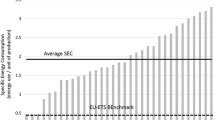Abstract
In analysis of technical efficiency in production, either the maximum proportional increase in all outputs or a minimal proportional scaling down of all inputs is generally selected as the criterion. In the recent literature, the directional distance function combines the two objectives by increasing outputs and reducing inputs simultaneously to the extent possible. This paper introduces a reverse directional distance function as one possible approach to resolve the conflict between incompatible goals through a minimal adjustment applicable to both of the two objectives. In our empirical analysis we apply the proposed method to Indian manufacturing where increasing the output and conserving energy use are both highly important objectives. A comparison of the feasible targets obtained through the conventional and the reverse directional distance functions yields an estimated tradeoff between output increase and CO2 reduction (due to energy conservation) along the frontier.


Similar content being viewed by others
Notes
There may, of course, be multiple bundles all of which are optimal.
India Energy Outlook, World Energy Outlook Special Report, International Energy Agency (2015).
See Ebinger (2016) for a discussion of the challenges involved in India’s industrialization and climate change goals.
Note that a unit of energy saved is more than a unit of energy produced because it avoids the loss that typically occurs in the transmission and distribution process.
If \( (1 - \theta^{*} ) > (\varphi^{*} - 1),\,\kappa > 1 \) and the projection based on the Reverse DDF will show a greater degree of input saving compared to the conventional DDF. The opposite would be true if \( (1 - \theta^{*} ) < (\varphi^{*} - 1). \)
The data are reported by accounting year which runs from April 1st to March 31st. Thus, the year 2013-14 refers to the period April 1, 2013 to March 31, 2014.
For the output measure, the gross value of manufacturing production was deflated by the wholesale price index for manufactured products. For the inputs, the value of fixed capital was deflated by the wholesale price index of machinery and machine tools. The expenditure on fuels was deflated by the wholesale price index for fuel and power. Similarly, the expenditure on materials was deflated by the wholesale price index for non-food primary articles.
The state of Andhra Pradesh lost its size advantage after the bifurcation of the state.
Authors’ calculation based on Annual Survey of Industries Table 6A for 2013–2014. Values were deflated using 2004–2005 prices.
See Hong and Slatick (1994).
References
Aparacio, J., Pastor, J. T., & Ray, S. C. (2013). An overall measure of technical efficiency at the firm and at the industry level: The ‘lost profit on outlay’. European Journal of Operational Research, 226, 154–162.
Athanassopoulis, A. (1995). Goal programming and data envelopment analysis (GoDEA) for target based multi-level planning: allocating central grants to the greek local authorities. European Journal of Operational Research, 87, 35–50.
Athanassopoulis, A. (1998). Decision support for target-based resource allocation of public services in multiunit and multilevel systems. Management Science, 39(10), 1261–1264.
Chambers, R. G., Chung, Y., & Färe, R. (1996). Benefit and distance functions. Journal of Economic Theory, 70, 407–419.
Ebinger, C. K. (2016) India’s energy and climate policy: Can India meet the challenge of industrialization and climate change? Brookings Energy Security and Climate Initiative, Policy Brief 16-01.
Hong, B. D., Slatick, E. R. (1994) Carbon Dioxide Emission Factors for Coal, U.S. Energy Information Administration, Quarterly Coal Report, January–April 1994, DOE/EIA-0121(94/Q1), Washington, DC, 1–8.
International Energy Agency (2015) India Energy Outlook, World Energy Outlook, Special Report.
Izadikhah, M., Roostaee, R., & Lotfi, F. H. (2014). Using goal programming method to solve DEA problems with value judgments. Yugoslav Journal of Operations Research, 24(2), 267–282.
Li, X. B., & Reeves, G. R. (1999). A multiple criteria approach to data envelopment analysis. European Journal of Operational Research, 115, 507–517.
Malekmohammadi, N., Lotfi, F. H., & Jaafar, A. B. (2011). Target setting in data envelopment analysis using MOLP. Applied Mathematical Modeling, 35, 328–338.
Mandal, S. K. (2010). Measuring environmental efficiency and cost of pollution abatement: An application of directional distance function to Indian Cement Industry. South Asian Journal of Management, 17(3), 23–37.
Mandal, S. K., & Madheswaran, S. (2010). Environmental efficiency of the Indian Cement Industry: An interstate analysis. Energy Policy, 38, 1108–1118.
Mukherjee, K. (2010). Measuring energy efficiency in the context of a developing economy: The case of Indian manufacturing. European Journal of Operational Research, 201, 933–941.
Shephard, R. W. (1970). Theory of cost and production functions. Princeton: Princeton University Press.
Tulkens, H., & Vanden Eeckaut, P. (1995). Non-frontier measures of efficiency, progress, and regress for time series data. International Journal of Production Economics, 39, 83–97.
Author information
Authors and Affiliations
Corresponding author
Rights and permissions
About this article
Cite this article
Ray, S.C., Mukherjee, K. A reverse directional distance function to reconcile between competing efficiency goals: an application to Indian manufacturing. Ind. Econ. Rev. 52, 103–126 (2017). https://doi.org/10.1007/s41775-017-0005-8
Published:
Issue Date:
DOI: https://doi.org/10.1007/s41775-017-0005-8




